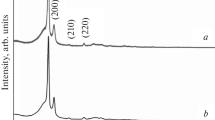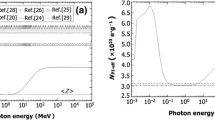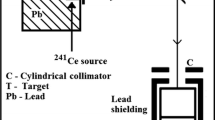Abstract
Mass attenuation coefficient (μ m) for polyethylene glycol (PEG) of different molecular weights was determined by using NaI (Tl) scintillator and WinXcom mixture rule at gamma energies of 59.5, 302.9, 356.0, 661.7, 1173.2 and 1332.5 keV. The total atomic, molecular and electronic cross sections, half-value layer, effective atomic and electron numbers, mass energy-absorption coefficients and kerma relative to air are calculated. The energy and compositional dependence of μ m values, and the related radiation absorption parameters, are evaluated and discussed. The experimental results agree well with the theoretical ones, within an uncertainty of 1% in the effective atomic number for all PEG samples at the designated energies.




Similar content being viewed by others
References
I.F. Al-Hamarneh, P.D. Pedrow, S.C. Goheen et al., Impedance spectroscopy study of composite thin fims of hydrated pplyethylene glycol. IEEE Trans. Plasma Sci. 35, 1518–1526 (2007). doi:10.1109/tps.2007.906136
S.T. Proulx, P. Luciani, A. Christiansen et al., Use of a PEG-conjugated bright near-infrared dye for functional imaging of rerouting of tumor lymphatic drainage after sentinel lymph node metastasis. Biomaterials 34, 5128–5137 (2013). doi:10.1016/j.biomaterials.2013.03.034
I.F. Al-Hamarneh, P.D. Pedrow, A. Eskhan et al., Synthesis and characterization of di(ethylene glycol) vinyl ether films deposited by atmospheric pressure corona discharge plasma. Surf. Coat. Technol. 234, 33–41 (2013). doi:10.1016/j.surfcoat.2013.06.112
M. Zhu, G. Carta, Adsorption of polyethylene-glycolated bovine serum albumin on macroporous and polymer-grafted anion exchangers. J. Chromatogr. A 1326, 29–38 (2014). doi:10.1016/j.chroma.2013.12.007
F.N. Topchieva, N.V. Efremova, Conjugates of Proteins with Block Co-polymers of Ethylene and Propylene Oxides. Biotechnol. Genet. Eng. Rev. 12, 357–382 (1994). doi:10.1080/02648725.1994.10647916
F. Zhang, E.T. Kang, K.G. Neoh et al., Modification of gold surface by grafting of poly(ethylene glycol) for reduction in protein adsorption and platelet adhesion. J. Biomater. Sci. Polym. E. 12, 515–531 (2001). doi:10.1163/156856201300194252
B. Dong, H. Jiang, S. Manolache et al., Plasma-mediated grafting of poly(ethylene glycol) on polyamide and polyester surfaces and evaluation of antifouling ability of modified substrates. Langmuir 23, 7306–7313 (2007). doi:10.1021/la0633280
F.J. Xu, K.G. Neoh, E.T. Kang, Bioactive surfaces and biomaterials via atom transfer radical polymerization. Prog. Polym. Sci. 34, 719–761 (2009). doi:10.1016/j.progpolymsci.2009.04.005
M.Y. Bai, S.Z. Liu, A simple and general method for preparing antibody- PEG-PLGA sub-micron particles using electrospray technique: an in vitro study of targeted delivery of cisplatin to ovarian cancer cells. Colloids Surf. B 117, 346–353 (2014). doi:10.1016/j.colsurfb.2014.02.051
A. Larsson, T. Ekblad, O. Andersson et al., Photografted poly(ethylene glycol) matrix for affinity interaction studies. Biomacromolecules 8, 287–295 (2007). doi:10.1021/bm060685g
F. Brétagnol, H. Rauscher, M. Hasiwa et al., The effect of sterilization processes on the bioadhesive properties and surface chemistry of a plasma-polymerized polyethylene glycol film: XPS characterization and L929 cell proliferation tests. Acta Biomater. 4, 1745–1751 (2008). doi:10.1016/j.actbio.2008.06.013
F.J. Xu, K.G. Neoh, E.T. Kang, Bioactive surfaces and biomaterials via atom transfer radical polymerization. Prog. Polym. Sci. 34, 719–761 (2009). doi:10.1016/j.progpolymsci.2009.04.005
S. Zanini, C. Riccardi, E. Grimoldi et al., Plasma-induced graft-polymerization polyethylene glycol acrylate on polyproylene films: chemical characterization and evaluation of the protein adsorption. J. Colloid Interface Sci. 341, 53–58 (2010). doi:10.1016/j.jcis.2009.09.012
F. Akman, R. Durak, M.F. Turhan et al., Studies on effective atomic numbers, electron densities from mass attenuation coefficients near the K edge in some samarium compounds. Appl. Radiat. Isot. 101, 107–113 (2015). doi:10.1016/j.apradiso.2015.04.001
M.I. Sayyed, Investigation of shielding parameters for smart polymers. Chin. J. Phys. 54, 408–415 (2016). doi:10.1016/j.cjph.2016.05.002
A. Kumar, Studies on effective atomic numbers and electron densities of nucleobases in DNA. Radiat. Phys. Chem. 127, 48–55 (2016). doi:10.1016/j.radphyschem.2016.06.006
T.K. Kumar, K.V. Reddy, Effective atomic numbers for materials of dosimetric interest. Radiat. Phys. Chem. 50, 545–553 (1997). doi:10.1016/s0969-806x(97)00089-3
N. Koç, H. Özyol, Z-dependence of partial and total photon interactions in some biological samples. Radiat. Phys. Chem. 59, 339–345 (2000). doi:10.1016/s0969-806x(00)00299-1
N.G. Nayak, M.G. Vijaya, K. Siddappa, Effective atomic numbers of some polymers and other materials for photoelectric process at 59.54 keV. Radiat. Phys. Chem. 61, 559–561 (2001). doi:10.1016/s0969-806x(01)00332-2
T. Singh, U.Kaur Rajni et al., Photon energy absorption parameters for some polymers. Ann. Nucl. Energy 37, 422–427 (2010). doi:10.1016/j.anucene.2009.12.017
I. Han, M. Aygun, L. Demir et al., Determination of effective atomic numbers for 3d transition metal alloys with a new semi-empirical approach. Ann. Nucl. Energy 39, 56–61 (2012). doi:10.1016/j.anucene.2011.09.008
M.W. Marashdeh, I.F. Al-Hamarneh, E.M. Abdel Munem et al., Determining the mass attenuation coefficient, effective atomic number, and electron density of raw wood and binderless particleboards of Rhizophora spp. by using Monte Carlo simulation. Results Phys. 5, 228–234 (2015). doi:10.1016/j.rinp.2015.08.009
M. Kurudirek, Studies on heavy charged particle interaction, water equivalence and Monte Carlo simulation in some gel dosimeters, water, human tissues and water phantoms. Nucl. Instrum. Methods A 795, 239–252 (2015). doi:10.1016/j.nima.2015.06.001
M. Kurudirek, S. Kurudirek, Collisional, radiative and total electron interaction in compound semiconductor detectors and solid state nuclear track detectors: effective atomic number and electron density. Appl. Radiat. Isot. 99, 54–58 (2015). doi:10.1016/j.apradiso.2015.02.011
M. Kurudirek, Effective atomic numbers, water and tissue equivalence properties of human tissues, tissue equivalents and dosimetric materials for total electron interaction in the energy region 10 keV–1 GeV. Appl. Radiat. Isot. 94, 1–7 (2014). doi:10.1016/j.apradiso.2014.07.002
M. Kurudirek, Effective atomic numbers and electron densities of some human tissues and dosimetric materials for mean energies of various radiation sources relevant to radiotherapy and medical applications. Radiat. Phys. Chem. 102, 139–146 (2014). doi:10.1016/j.radphyschem.2014.04.033
S.R. Benhabbour, H. Sheardown, A. Adronov, Protein resistance of PEG-functionalized dendronized surfaces: effect of PEG molecular weight and dendron generation. Macromolecules 41, 4817–4823 (2008). doi:10.1021/ma8004586
B. Dong, S. Manolache, A.C.L. Wong et al., Antifouling ability of polyethylene glycol of different molecular weights grafted onto polyester surfaces by cold plasma. Polym. Bull. 66, 517–528 (2011). doi:10.1007/s00289-010-0358-y
D. Mech, J.S. Sangwai, Effect of molecular weight of polyethylene glycol (PEG), a hydrate inhibitive water-based drilling fluid additive, on the formation and dissociation kinetics of methane hydrate. J. Nat. Gas Sci. Eng. 35, 1–12 (2016). doi:10.1016/j.jngse.2016.06.020
G.C. Lowenthal, P.L. Airey, Practical Applications of Radioactivity and Nuclear Radiations (Cambridge University Press, Cambridge, 2001). doi:10.1017/cbo9780511535376.005
J.H. Hubbell, Photon mass attenuation and energy-absorption coefficients. Int. J. Appl. Radiat. Isot. 33, 1269–1290 (1982). doi:10.1016/0020-708x(82)90248-4
L. Gerward, N. Guilbert, K.B. Jensen et al., WinXCom-a program for calculating x-ray attenuation coefficients. Radiat. Phys. Chem. 71, 653–654 (2004). doi:10.1016/j.radphyschem.2004.04.040
J.H. Hubbell, S.M. Seltzer, Tables of x-ray mass attenuation coefficients and mass energy-absorption coefficients 1 keV to 20 MeV for elements Z = 1 to 92 and 48 additional substances of dosimetric interest. NISTIR-5632 (1995)
F. Akman, R. Durak, M.R. Kacal et al., Study of absorption parameters around the K edge for selected compounds of Gd. X-Ray Spectrom. 45, 103–110 (2016). doi:10.1002/xrs.2676
Z. Yalçin, O. İçelli, M. Okutan et al., A different perspective to the effective atomic number (Zeff) for some boron compounds and trommel sieve waste (TSW) with a new computer program ZXCOM. Nucl. Instrum. Methods Phys. Res. A 686, 43–47 (2012). doi:10.1016/j.nima.2012.05.041
M. Taylor, R. Franich, J. Trapp et al., Electron interaction with gel dosimeters: effective atomic numbers for collisional, radiative and total interaction processes. Radiat. Res. 171, 123–126 (2009). doi:10.1667/rr1438.1
A. Perumallu, A.N. Rao, G.K. Rao, Photon interaction measurements of certain compounds in the energy range 30–660 keV. Can. J. Phys. 62, 454–459 (1984). doi:10.1139/p84-064
A. El-Kateb, A. Abdul-Hamid, Photon attenuation coefficient study of some materials containing hydrogen, carbon and oxygen. Int. J. Radiat. Appl. Instrum. 42, 303–307 (1991). doi:10.1016/0883-2889(91)90093-g
K. Singh, H. Singh, V. Sharma et al., Gamma-ray attenuation coefficients in bismuth borate glasses. Nucl. Instrum. Methods B 194, 1–6 (2002). doi:10.1016/s0168-583x(02)00498-6
F.H. Attix, Introduction to Radiological Physics and Radiation Dosimetry (Wiley, New York, 1986). doi:10.1002/9783527617135
S.R. Manohara, S.M. Hanagodimath, K.S. Thind et al., On the effective atomic number and electron density: a comprehensive set of formulas for all types of materials and energies above 1 keV. Nucl. Instrum. Methods B 266, 3906–3912 (2008). doi:10.1016/j.nimb.2008.06.034
J.H. Hubbell, S.M. Seltzer, Tables of X-Ray Mass Attenuation Coefficients and Mass Energy-Absorption Coefficients (version 1.4). Radiat. Biomolecular. Phys. Division, PML, NIST (2004). http://physics.nist.gov/xaamdi
K.S. Mann, M.S. Heer, A. Rani, Effect of low-Z absorber’s thickness on gamma-ray shielding parameters. Nucl. Instrum. Methods A 797, 19–28 (2015). doi:10.1016/j.nima.2015.06.013
M. Kurudirek, Effective atomic number, energy loss and radiation damage studies in some materials commonly used in nuclear applications for heavy charged particles such as H, C, Mg, Fe, Te, Pb and U. Radiat. Phys. Chem. 122, 15–23 (2016). doi:10.1016/j.radphyschem.2016.01.012
Acknowledgements
The authors also thank all members of the Nuclear Science Research Institute at the King Abdulaziz City for Science and Technology in Riyadh, Saudi Arabia, for providing the facilities to conduct the experiments.
Author information
Authors and Affiliations
Corresponding author
Additional information
The authors thank the Deanship of Scientific Research at Al Imam Mohammad Ibn Saud Islamic University for the grant and financial assistance to accomplish this work.
Rights and permissions
About this article
Cite this article
Al-Hamarneh, I.F., Marashdeh, M.W., Almasoud, F.I. et al. Determination of gamma-ray parameters for polyethylene glycol of different molecular weights. NUCL SCI TECH 28, 157 (2017). https://doi.org/10.1007/s41365-017-0311-y
Received:
Revised:
Accepted:
Published:
DOI: https://doi.org/10.1007/s41365-017-0311-y




